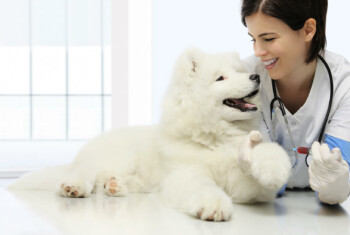BluePearl nutritionist explains why obesity is a problem amid Pet Obesity Awareness Month.
Over the last ten years, pet obesity has become what many experts call a national epidemic, with one in three dogs and cats now overweight, and these numbers are expected to grow.
BluePearl Specialty and Emergency Pet Hospital, a leading provider of advanced veterinary services with over 90 practices in 26 states across the U.S., launched its own investigation into the prevalence of pet obesity and found a 24% increase in the number of overweight dogs treated at its practices over the last seven years. Furthermore, in 2020, 52% of dogs and 56% of cats treated at BluePearl were overweight.
Lindsey E. Bullen, DVM, Diplomate ACVN, Board Certified Veterinary Nutritionist® at BluePearl Specialty and Emergency Pet Hospitals in Durham, Raleigh, and Cary North Carolina, and Adjunct Professor at Lincoln Memorial University-College of Veterinary Medicine, points to overfeeding, lack of exercise, breed and genetics, injuries, and diseases like arthritis, which keep pets from being active, as possible reasons for the uptick in pudgy pets. While most owners know it is unhealthy for pets to be overweight, Dr. Bullen says in drastic circumstances like these, it is easy to fall into bad feeding habits.
People are spending more time at home with their pets, which makes overfeeding and overtreating a greater possibility. Owners that are more likely to get up and move—those who get a bit stir crazy while working from home—may be taking on more of an active role regarding their pet’s activity levels. This means more walks and playtime,” explained Dr. Bullen.
“Alternatively, people who are finding it difficult to balance their personal and professional lives may be interacting less with their pets, and to show their affection are giving pets more treats. Also, pets who aren’t used to having their owners home all day are now given many more opportunities to bug them for attention and treats. Unfortunately, these modern-day realities can and likely will negatively impact pet weight.”
Over the last four months, Dr. Bullen says her caseload has soared. She attributes this boost in clientele to one of two things: Economic hardship or the availability of both commercial and homemade food ingredients.
“Many clients whose pets are on premium pet foods either can no longer afford the food or are having trouble finding the food due to back-orders. These clients then come to me looking for dietary revisions or for homemade diets,” Dr. Bullen explained.
“Conversely, those with pets on homemade diets are asking for commercial diet recommendations or reformulations because meat and other ingredients are out-of-stock. Whether due to economic hardship or panic that results in people bulk-buying pet foods, foods are not as readily available as they once were, and finances make all the difference. Every diet is different in terms of nutrient profile and calories per cup, or caloric density, and if there isn’t someone there to help the owner figure out those calculations it is easy to over- or even underfeed your pet—especially, if you are switching diets,” she added.
Excess weight can cause damage or contribute to the dysfunction of pets’ circulatory and respiratory systems. Additionally, while many people believe adipose tissue (fat) is inert, it is not. According to Dr. Bullen, adipose tissue is metabolically active and secretes hormones, some of which are pro-inflammatory. Therefore, overweight or obese pets with chronic diseases such as pancreatitis, diabetes, or feline lower urinary tract disease, or with cardiac, respiratory, or renal issues, can be particularly challenging to treat.
Even in otherwise healthy pets, Dr. Bullen explained that extra adipose tissue will predispose them to orthopedic issues, as there is added pressure to joints and bones.
As we enter the holiday season—when many of us are spending time enjoying meals with family, friends, and our furry companions—it is important we remember the dangers related to pet obesity, and know the ways in which we can help keep pets at a healthy weight.
Follow these tips to help keep your pet healthy
- Be cautious when giving your pet human food. Did you know just one biscuit is the equivalent to one and a half burgers to a medium-sized dog, and just one small cup of whole milk is the equivalent to three burgers to a medium-sized cat? While tempting to give to pets, human food, even in small quantities, can represent a large percent of your pet’s daily caloric intake, and may cause digestive discomfort or lead to unintended consequences like toxicity or intestinal blockage. Be cautious when giving your pet human food—especially if it is not normally on the menu.
- Don’t give in to begging. Giving in to begging may seem harmless but it can easily lead to overfeeding, and subsequent obesity. Try to determine the reason your pet is begging. Are they behaving this way to gain your attention? Is this another way of saying “let’s play?” Next time your dog or cat is begging, see if some playtime or grooming will satisfy them. If this does not work, try feeding your pet a specifically formulated weight management diet to help keep your pet satisfied between meals.
- Make mealtimes fun. It’s all about portion control. Splitting your pet’s food into smaller, more frequent meals throughout the day helps to prevent hunger. Try scatter feeding your pet using dry food. This will slow down their eating while encouraging them to be more active. You can also try slow or puzzle feeders or even small treasure hunts to extend mealtime and keep your pet mentally stimulated.
- Use a digital scale. Digital scales help ensure daily feeding allowance accuracy. Measuring cups can lack accuracy and cause unintentional over-feeding. If you are switching diets, keep in mind that every diet is different in terms of nutrient profile and calories per cup. Speak to your veterinarian if you have questions about appropriate caloric intake for your pet. Also, remember that some of pets’ daily allowances should be saved for treats—if treats are on the menu.
- Opt for healthy treats. Vegetables such as carrots are good, healthy snacks for dogs. For obese or slightly overweight pets, keep in mind that treats should be less than 10 percent of a pet’s total daily caloric intake—this includes treats used for training and medication administration like peanut butter, cheese, and deli meats. The other 90 percent of a pet’s daily caloric intake should come from a complete and balanced diet. Be sure to take every calorie into consideration when developing your pet’s dietary plan.
- Involve the whole family. Make sure the whole family is aware of the feeding regimen, including children. If hosting guests, apprise them on dietary restrictions for your pet and ensure there is no feeding of human foods.
- Stay active. Ensure regular exercise or activities for your pet. Take your dog on regular walks and play catch, when possible. Though cats can be harder to persuade to exercise, the use of toys and gadgets like a laser pointer can be a good way to promote play. Also, ensure they have toys for independent play such as ping pong balls, jingle balls, mazes, and catnip toys.
Dog weight loss tips directly from veterinarians can help keep your pet happy and healthy for many years to come.
A Dangerous New Normal
Obesity has the potential to not only rob pets of their quality of life, but also steal years that could have been spent with their loved ones. Despite this common reality, many pet owners are unaware that their pet is obese or overweight. This phenomenon is what experts now refer to as the “fat pet gap” or the normalization of obesity by pet owners.
“Over time, overweight pets have become the new norm, so many pet owners do not realize their pet is overweight or obese. It is our job as veterinary professionals to educate the owner on this very sensitive subject and improve the health and quality of life for their pet,” explained Dr. Bullen.
“Pet owners must take weight management and nutrition more seriously and understand that what we feed our pets directly impacts their health and longevity. Who wouldn’t want three or four more years with their furry friend?”


